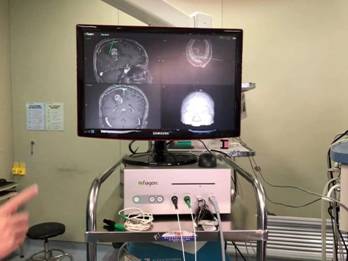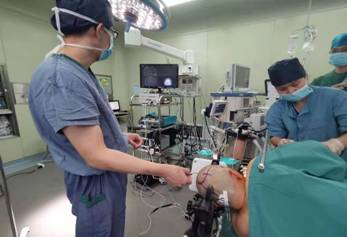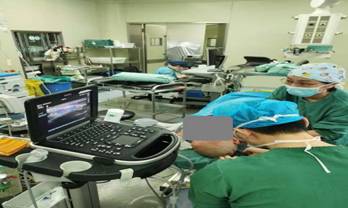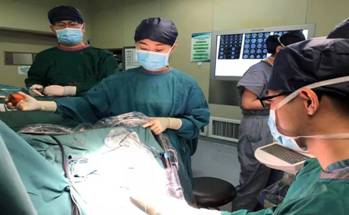On September 13, Department of Anesthesiology and Perioperative Medicine cooperated with Department of Neurosurgery of the First Affiliated Hospital of Xi’an Jiaotong University (XJTU) to successfully complete the first case of deep tumor resection in the functional brain area by electromagnetic navigation combined with intraoperative awakening technology in Northwest China. Postoperatively, the limb function of the patient was preserved to the maximum extent.

Electromagnetic navigation platform
The 47-year-old female patient underwent brain tumor resection two months ago and presented with the left lower limb weakness after operation, which was gradually worsened for 1 month. The brain tumor, located in the deep part of the right central anterior gyrus, was significantly enlarged, which compressed nerve conduction bundle and affected the left limb movement. How to completely remove the tumor and preserve the limb function to the maximum extent are the difficulties of surgery. Electromagnetic navigation system is a high-tech platform integrating modern stereo-orientation, computer imaging, electromagnetic coded signal tracking and other technologies, which can construct three-dimensional images of intracranial tumor lesions before surgery and is beneficial to accurate positioning of deep brain lesions and the planning of surgical incisions. Intraoperatively, it can deliver real-time monitoring of tumor margin and protect the functional cortex and vital nerve vessels. Considering the specialty of this case, the team led by Professor Zhang Zhonglin and Professor Wang Tuo collaborated with Department of Anesthesiology and Perioperative Medicine, Department of Ultrasound and Department of Medical Imaging to determine an explicit surgical regimen for this patient. The most advanced electromagnetic navigation-assisted intraoperative awakening technology was adopted for the tumor resection in the functional brain area.

Preoperative electromagnetic navigation-assisted surgical regimen

Preoperative anesthesia preparations for intraoperative awakening

Intraoperative navigation and positioning
Preoperatively, Director Wang Qiang and Deputy Director Zhang Linjuan of Department of Anesthesiology and Perioperative Medicine delivered in-depth communication and discussion regarding the patient's condition and surgical regimen with the team ofDepartment of Neurosurgery, aiming to make full preparations for surgical cooperation, equipment dressing and materials. On the day of surgery, Tan Jing, Deputy Chief Physician from Department of Anesthesiology and Perioperative Medicine, guided the anesthesia procedures, and the patient was smoothly awakened during the operation, clearly expressed her feelings and cooperated with the instructions from the surgeons, providing potent guarantee for the success of surgery. Throughout the operation, visiting nurses closely observed the surgical process and ensured timely supply of intraoperative materials. In addition, the nurses quickly and accurately delivered the required devices. Perfect cooperation significantly enhanced surgical efficiency and safety.
Through intimate cooperation and efforts among multiple disciplines,surgical team, nursing team and anesthesia team eventually achieved complete resection of the deep brain tumor, and properly preserved the language and motor function of this patient.